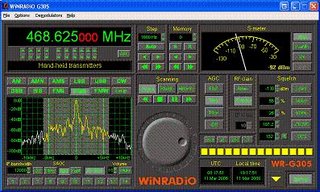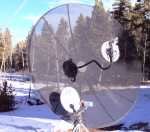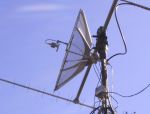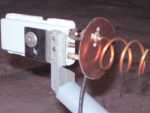How to Measure SWR
SWR is the Standing Wave Ratio measurement of your radio's
antenna system. Radio systems with too high of an SWR will
not function properly, perhaps even ruining some of the
components if the condition is not corrected.
SWR may be expressed in two ways: in terms of power
("I have a reflected power of 5 watts"), or in terms of the actual
ratio ("I have an SWR of 3:1"). Many hams will strive to keep their
SWR below 3:1. I personally strive to keep it at 1.5:1 It is not good
to become too obsessive over a flat SWR though... as if you move your
vehicle, or re-hang your antenna, that measure will move.
It is important to note that an SWR measurement is accurate
at a specific frequency. For example, I may have an SWR
measurement of 1.5:1 at 146.00 MHz, but if I were to tune my
radio to 147.00 MHz, the SWR would be slightly different,
perhaps 1.6:1 When tuning your antenna, it is important to
choose a low SWR across the band you wish to operate on.
Also, if your antenna has multiple bands on it, you will need
to measure the SWR for each of those bands.
Types of SWR Meters
I have seen two types of meters on the market: a single-needle
meter that requires a calibration, and a dual-needle model
that shows the forward and reflected power at the same time,
and the SWR is read in the middle of the scale. Which one you
use is a personal preference; I like the single needle models as
I can calibrate them manually. Others, looking for a quick reading,
would prefer the dual-needle model. SWR meters are restricted
to certain frequencies... it is very likely that a meter useful on
HF will not work for VHF antennas. Most hams will require
2 or 3 SWR meters to fully cover all frequencies that they transmit on.
Single-needle MetersEamples of a Single-needle meter is shown below:

This meter covers 140 - 525 MHz, and will handle up to 200W of power. The meter is read by first calibrating it for the proper power level, and then reading the SWR. This meter can also read the raw FWD (forward, or desired) power, and the REF (reflected, undesired) power levels. The SWR is a ratio describing these two power levels.
How to use this type of meter:
1) Connect the cables on the back of the meter to the antenna and the transmitter. Make sure the transmitter is off. Also make sure that the ANT connection goes to your antenna, and that the TX connection goes to your Transmitter. Do not reverse these connections.
2) Select the range of your transmitter. If you are going to transmit using 50W, make sure you do not use the 20W setting, or you will burn out the meter. I suggest transmitting a 10W signal for testing, unless you built the antenna you are testing out... then use the lowest possible setting.
3) Turn the Calibration knob (the big black circular knob) to the middle position.
4) Set the Function switch to CAL (calibration).
5) Turn on your radio, and find an unused frequency. It is rude to test your equipment while other people are talking. It is also not a good idea to test through repeaters... if you want to test your antenna on a repeater input, move off a couple kHz, and change the tone.
6) Check your power levels again. Make sure that your Range is correct.
7) Select a FM or AM signal and key up your transmitter. SSB will not work -- the carrier of an SSB is a function of the amplitude of the sound coming into it, and the signal is not steady. If the needle pegs to the left, let go! Some setting is not calibrated correctly. If your range is correct, turn the calibration knob counter-clockwise and try again. If the needle doesn't move much, turn the calibration knob clockwise. Ideally, you would like the needle to align with the word CAL at the right end of the scale. If you are transmitting into an antenna (instead of a dummy load), be sure to ID.
8) Once the needle is aligned with CAL, move the FUNCTION lever to SWR. The needle should swing back left, and hopefully settle between 1.1 and 2.0 This is your actual SWR reading. Let's say that you read 1.7 SWR. In discussions with others, you would say that you have an SWR of 1.7 to 1, and would write it 1.7:1
9) If you would like to see the actual power levels, switch the FUNCTION lever to POWER, and work the POWER level to FWD and REF. The FWD power should be significantly larger than the REF value.
10) If your SWR is greater than 2.5, your antenna system has some concerns. Depending on who you talk to, anything less than 3 or so is "acceptable". Personally, I strive to keep my antenna systems below 1.5:1.
Dual Needle Meters
An illustration of a Dual Needle meters is shown below:

A dual-needle meter will likely have a switch for the power level, and perhaps one for which band is being tested.
Dual-needle meters do not need to be calibrated, aside from making sure that the needles are resting on zero when the meter is at rest. The left needle (the one in red on my diagram) typically
shows the FWD (forward) power, and the right needle (in blue on my diagram) typically shows the REF (reflected) power. The SWR is read where the two needles intersect, as suggested by the light green line in the middle.
There is no hard standard on what role each needle on the meter has.... the only standard is that the SWR reading is recorded from the intersection of the two needles. Whenever using this style of needle, make sure that the cables are connected properly, and that you read the calibration scales before attempting to use.
Some Other Thoughts
* A perfect SWR does not indicate a well-performing antenna installation. Remember, dummy loads should be well balanced, but they do not make good antennas.
* You can use a meter like this to test feed line. Hook up a dummy load to the antenna connection on the meter. Hook up a short piece of coax to the TX side of the meter, and place into the radio. Set your RANGE properly, and put the FUNCTION into POWER mode , and the POWER selector into FWD. Key your radio, and record the reading. Now, remove the short piece of coax, and attach the long feedline to the meter and to the transmitter. Key the radio, and record the new reading. The first reading should be larger than the second one. First reading minus (-) the second reading will be your lost energy due to coax transfer.
* More than one person has asked if it is safe to keep the SWR meter in an antenna circuit. For HF, where your radio may be constantly changing bands, the SWR meter will be quite handy to have inline while changing antennas and bands. For VHF/UHF repeater use, your SWR will probably not change as much (then again, because of the scales of the frequency, HF has a lot more physical antenna to work with!). Your SWR meter will introduce a small loss into your antenna system, so you might not hear the faintest systems, but on the whole, the SWR meter permanently in line will not harm it, or cause it to burn out. Just be sure, that if you are changing power levels, that you keep the RANGE selection in the proper location.
Written by: KC0ARF, June 2004








